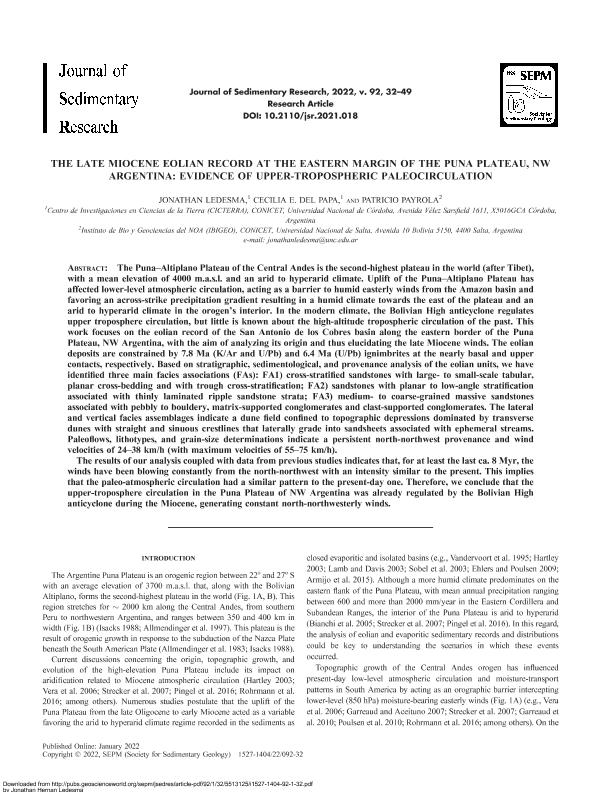Artículo
The late Miocene eolian record at the eastern margin of the Puna Plateau, NW Argentina: Evidence of upper-tropospheric paleocirculation
Fecha de publicación:
01/2022
Editorial:
Society for Sedimentary Geology
Revista:
Journal of Sedimentary Research - (Print)
ISSN:
1527-1404
Idioma:
Inglés
Tipo de recurso:
Artículo publicado
Clasificación temática:
Resumen
The Puna–Altiplano Plateau of the Central Andes is the second-highest plateau in the world (after Tibet), with a mean elevation of 4000 m.a.s.l. and an arid to hyperarid climate. Uplift of the Puna–Altiplano Plateau has affected lower-level atmospheric circulation, acting as a barrier to humid easterly winds from the Amazon basin and favoring an across-strike precipitation gradient resulting in a humid climate towards the east of the plateau and an arid to hyperarid climate in the orogen’s interior. In the modern climate, the Bolivian High anticyclone regulates upper troposphere circulation, but little is known about the high-altitude tropospheric circulation of the past. This work focuses on the eolian record of the San Antonio de los Cobres basin along the eastern border of the Puna Plateau, NW Argentina, with the aim of analyzing its origin and thus elucidating the late Miocene winds. The eolian deposits are constrained by 7.8 Ma (K/Ar and U/Pb) and 6.4 Ma (U/Pb) ignimbrites at the nearly basal and upper contacts, respectively. Based on stratigraphic, sedimentological, and provenance analysis of the eolian units, we have identified three main facies associations (FAs): FA1) cross-stratified sandstones with large- to small-scale tabular, planar cross-bedding and with trough cross-stratification; FA2) sandstones with planar to low-angle stratification associated with thinly laminated ripple sandstone strata; FA3) medium- to coarse-grained massive sandstones associated with pebbly to bouldery, matrix-supported conglomerates and clast-supported conglomerates. The lateral and vertical facies assemblages indicate a dune field confined to topographic depressions dominated by transverse dunes with straight and sinuous crestlines that laterally grade into sandsheets associated with ephemeral streams. Paleoflows, lithotypes, and grain-size determinations indicate a persistent north-northwest provenance and wind velocities of 24–38 km/h (with maximum velocities of 55–75 km/h). The results of our analysis coupled with data from previous studies indicates that, for at least the last ca. 8 Myr, the winds have been blowing constantly from the north-northwest with an intensity similar to the present. This implies that the paleo-atmospheric circulation had a similar pattern to the present-day one. Therefore, we conclude that the upper-troposphere circulation in the Puna Plateau of NW Argentina was already regulated by the Bolivian High anticyclone during the Miocene, generating constant north-northwesterly winds.
Palabras clave:
Eolian sedimentation
,
Miocene
,
Puna-Altiplano
,
Bolivian High
Archivos asociados
Licencia
Identificadores
Colecciones
Articulos(IBIGEO)
Articulos de INST.DE BIO Y GEOCIENCIAS DEL NOA
Articulos de INST.DE BIO Y GEOCIENCIAS DEL NOA
Citación
Ledesma, Jonathan Hernán; del Papa, Cecilia Eugenia; Payrola Bosio, Patricio Augusto; The late Miocene eolian record at the eastern margin of the Puna Plateau, NW Argentina: Evidence of upper-tropospheric paleocirculation; Society for Sedimentary Geology; Journal of Sedimentary Research - (Print); 92; 1; 1-2022; 32-49
Compartir
Altmétricas




